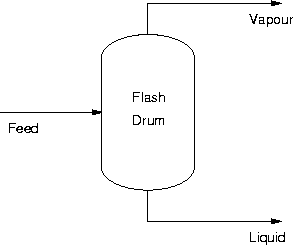
In each of these sections there will be a degrees of freedom analysis, some discussion on control strategies and then a few examples. Note that distillation columns will be dealt with in a separate section.

Before we can attempt to control this process we have to know how many streams we are allowed to manipulate i.e. the control degrees of freedom. This can be evaluated by the equation
d.o.f = unknowns - equations
Unknowns
There are 3 streams in this process. Each stream has unknown composition, temperature and pressure. Thus for a stream with C components there are
3 [C + 2] = 3C + 6 unknowns
Equations
In an adiabatic flash there are
Hence altogether there are
2C + 3 constraints
Degrees of Freedom
From the above we can evaluate that we have
C + 3 degrees of freedom
However we know the composition, temperature and pressure of the input stream. These were considered unknowns for the above calculations but now can be taken into account. Thus this adds on another C + 1 constraints and so we now have
2 control degrees of freedom or C.D.F
This answer can be compared with that obtained directly using the equation below.
C.D.F = no. of connections + 1 - no. of phases
Of the two streams left one would normally have a flow controller and be used to regulate throughput. This could be any of the three streams. This leaves one other to regulate a strategic variable.
From a knowledge of the properties of the adiabatic flash, the normal design specification is the feed and only one further quantity, usually pressure, but temperature or another flow could also be chosen.
Figure 1 below shows the alternatives for this set up.
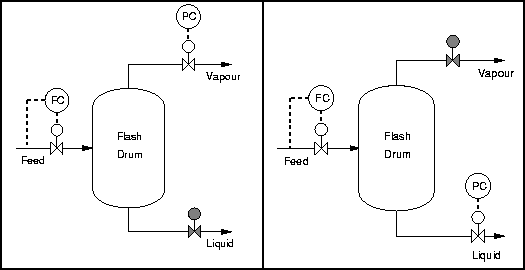
Figure 1 - Feed Rate Controlled
Figure 1 (a) is a very common arrangement and will work well. Both pressure and level loops have good adjustment-measurement sensitivity. There is some undesirable interaction because opening the pressure control valve increases the rate of boiloff and hence affects the level.
Figure 1 (b) will not work. Although as noted above the vapour rate affects level, altering the liquid rate does not change the pressure of the flash.
Figure 2 below shows the alternatives for regulation of vapour rate and pressure.
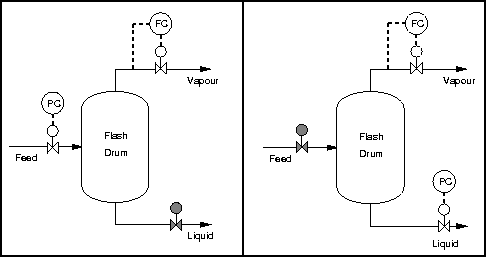
Figure 2 - Vapour Rate Controlled
Figure 2 (b) is unworkable for the same reasons given above for figure 1(b).
Finally figures 3 gives the two alternatives for liquid rate and pressure.
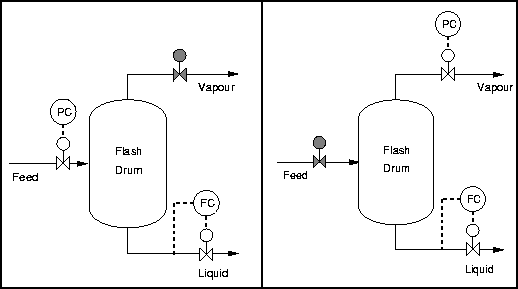
Figure 3 - Liquid Rate Controlled
It would be possible to devise other schemes in which the flow control loop acted indirectly. For example, by adjusting a stream other than the one which is measured as shown below in figure 4. Such arrangements should be avoided, as should any system in which the operation of one loop, here the flow control, depends also on the operation of another, here the inventory loop.
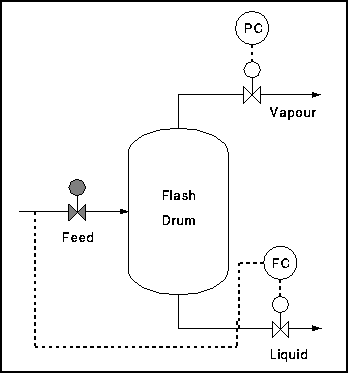
Figure 4 - Another Possibility?
As with the Adiabatic Flash we will start by evaluating the control degrees of freedom from the equation
d.o.f = unknowns - equations
Unknowns
In this example there are 4 streams associated with the flash. There are 3 process streams each with unknown composition, temperature and pressure, and 1 energy flow. This gives
3 [C + 2] + 1 = 3C + 7 unknowns
Equations
In a flash with heat input there are
Hence altogether there are
2C + 3 constraints
Degrees of Freedom
From the above we can evaluate that we have
C + 4 degrees of freedom
Now, as before, we can fix the composition, temperature and pressure of the feed stream. These C+2 constraints can be included in the above to give
3 control degrees of freedom
Once again this answer can be compared with that obtained directly.
C.D.F = no. of connections + 1 - no. of phases
The non-adiabatic flash separator has an additional adjustment not present in the adiabatic case, namely a heat input from a heating stream of steam or other utility. Analysis of the design problem, as shown in the previous section, confirms that there is a further degree of freedom and therefore a flowrate plus two further variables can be set. i.e. there are four possible adjustments we can manipulate, the three mentioned and the material balance maintained with the fourth.
The best procedure to adopt in these examples is the following.
Note that while it is usually important to locate strategic loops before choosing the manipulated variable for level, we have found that liquid rate does not affect either temperature or pressure. All other things being equal, this would be the preferred choice for the level control loop. As with the adiabatic example, the measurement ends of the control loops are not shown and the adjustment for the level loop is indicated by a shaded valve.
Figure 5 below shows the best arrangement for this option. In this case interchanging temperature and pressure loops could result in an inferior arrangement, as the feed rate would probably not have so direct an effect on temperature, but would still work.
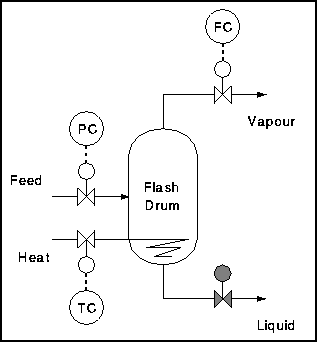
Figure 5 - Pressure, Temperature and Vapour Rate Regulated
Once flow controllers are placed on the liquid and vapour product streams, the third material stream, i.e. the feed, must be used to maintain the mass balance. This leaves only the heat input, steam, valve to regulate pressure. This is the only possible scheme and is shown below in figure 6.
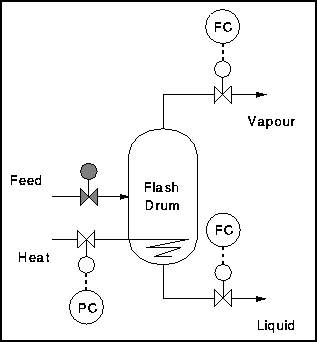
Figure 6 - Pressure, Liquid and Vapour Rates Regulated
To regulate a ratio requires a flow control loop on one stream, with its setpoint adjusted by a ratio controller. A flow measurement on the second stream feeds into the ratio controller which sees both flows and changes the setpoint of the flow controller accordingly. Thus only one of the ratioed streams has a valve, but both have flowmeters. In principal the valve may be on either stream.
A suitable arrangement is shown in Figure 7. The flow control valve for the ratio system has been located on the vapour line in order to leave the liquid line for level adjustment, as discussed above. Pressure control must then be by the heat input.
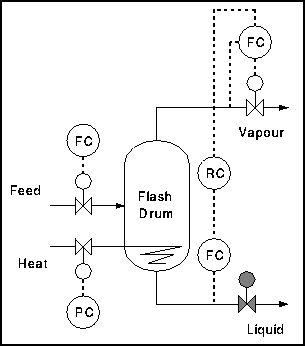
Figure 7 - Pressure, Liquid to Vapour Flow Ratio and Feedrate Regulated
One alternative is shown in figure 8 below. It would be possible here to put the valve for the ratio control on either feed or vapour streams. Also it is possible to interchange the temperature and pressure loops. The best choice would depend on the particular system: flowrates, component volatilities, etc. and would be determined after detailed modelling of the process.
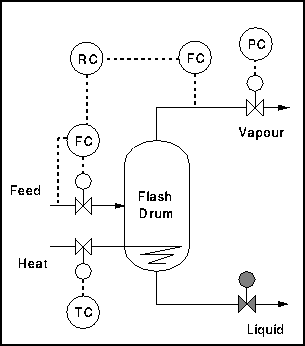
Figure 8 - Pressure, Temperature and Vapour to Feed Rate Ratio Regulated
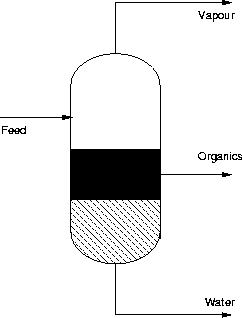
Figure 9 - Three Phase Flash
Now let us consider the degrees of freedom:
C.D.F = no. of streams - no. of interfaces
Typical control specifications would be feed rate and pressure. Note that two interfaces must be maintained with two control loops. An example of a control scheme is shown in the diagram below.
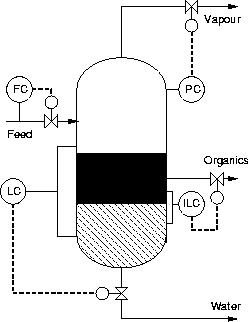
Figure 10 - Three Phase Flash With Control
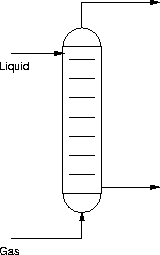
Figure 11 - Countercurrent Cascade Column
Now let us consider control.
C.D.F = no. of streams - no. of interfaces
For gas-liquid operations the three strategic variables to control would be
Below are three examples of controlling a cascade column with comments on how good or bad the control scheme is.
In this first example the control loops are:
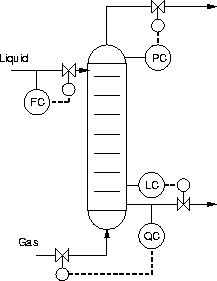
Figure 11 - Control Scheme 1
This is a good control scheme. All the adjustments have a direct effect on the controlled variables. In particular look at the composition control of the bottoms product. As you can see the adjustment and measurement are both at the bottom of the column.
In this second example the control loops are:
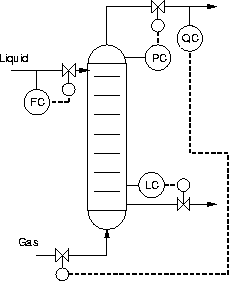
Figure 12 - Control Scheme 2
This is not quite as good as the previous example. The pressure, flowrate and level are as before. However this time the top composition is controlled using the flowrate of the gas entering at the bottom of the column. Hence this time there will be a time delay between making the adjustment and the composition changing to reflect this change. This will be the length of time taken by the gas too travel up the column.
Finally in this third example the control loops are:
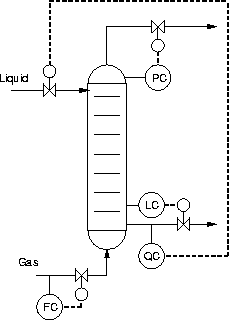
Figure 13 - Control Scheme 3
In this example the flowrate of the gas is constant and once again the pressure and level control are as before. However this time the bottoms composition is regulated using the liquid flowrate entering at the top of the column. So once again there will be a time delay between making the adjustment and seeing the effect of the adjustment, but this time it will be the length of time taken for the liquid to travel down the column - a significantly longer time. Hence this control scheme should be avoided.
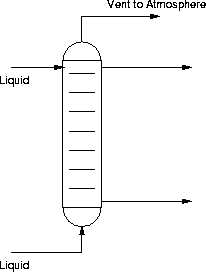
Figure 14 - Liquid-Liquid Extraction Column
In this case note that there is going to be some vapour present at the top of the column. This gives another phase and so the degrees of freedom analysis gives us:
C.D.F = no. of streams - no. of interfaces
A liquid-liquid column running full of both liquids would probably use implicit pressure regulation by leaving an open line to another part of the plant or alternatively may be vented to atmosphere. This effectively reduces the degrees of freedom to 2. Normally one flowrate and one composition of controlled along with the two interface control loops.
The example below shows the flowrate of the lighter liquid being controlled with the flowrate of the heavier liquid entering at the top of the column being used to regulate the composition of the top product. The two product streams are used for inventory.
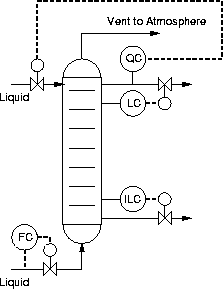
Figure 15 - Liquid-Liquid Extraction Column With Control